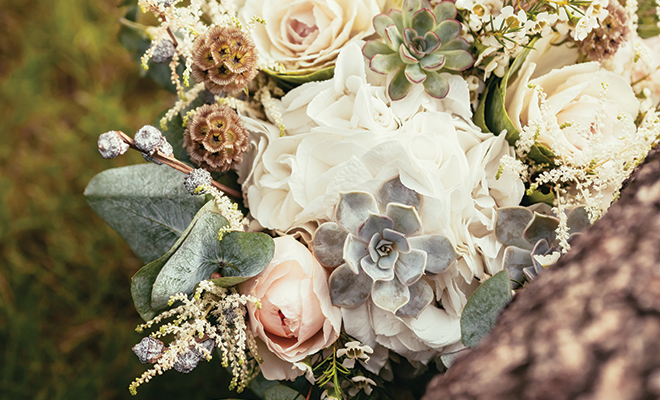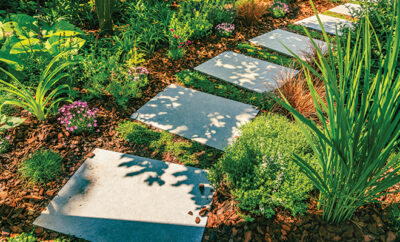
Succulents: The Lush Green Bridal Choice
Succulents, those chubby-looking plants that retain water in their leaves and stems, are one of the latest trends for weddings, and with good reason.
Whether they’re used alone or with cut flowers, their unique beauty adds a special touch to wedding décor. With hundreds of varieties to choose from, succulents are a perfect choice for a variety of wedding themes: rustic, bohemian, vintage or sophisticated.
When the weather heats up, succulents shine. Arrangements created several days ahead of time will still look fresh for the wedding, even during summer months in warm climates. Another benefit of succulents is that they bloom throughout the year in many areas, making them a competitive alternative to imported flowers and allowing you to have lusher floral arrangements.
In addition to their visual impact and low-maintenance benefits, succulents are one of the best plants for weddings from a green point of view. Succulents that are sourced locally avoid the environmental impacts associated with transportation and refrigeration. Best of all, they can be repurposed by transplanting after the big event. As the plants grow, the wedding becomes part of a living memory.
Since succulents are trending, florists are eager to incorporate them into wedding arrangements. They are often paired with big, bold blossoms such as roses, dahlias, peonies, hydrangeas and orchids. For non-traditional looks, they can be used in combination with cacti and air plants. Succulents lend themselves well to DIY decorations and can be found in almost any nursery or big box store. They’re available in nearly every shade of green, blue, red and purple and in a variety of shapes, from rosettes to trailing vines to spiky spears.
Succulents are an ideal alternative for brides who want a non-traditional, eco-friendly ceremony and reception. Here are some of the chic new ways these versatile plants are showing up at weddings.
Bouquets and Boutonnieres
You can draw inspiration from the hundreds of pictures on Pinterest of stunning bridal bouquets that incorporate succulents. Many feature one or more large echeveria or aeonium rosettes with pink or purple overtones surrounded by cut flowers and more succulents. Trailing succulents such as string of pearls can be added for a romantic touch. There are also images of one-of-a-kind bride’s and bridesmaid’s hairpieces made from succulents and manly boutonnieres for grooms and groomsmen created with two or three mini-succulents. Here’s a florist tip: if you’re making a bouquet or boutonniere with stemless succulents, use floral wire and tape to create longer stems, then wrap ribbon or burlap over the tape.
Centerpieces
There are probably as many ideas for succulent centerpieces as there are varieties of succulents. Some of the most spectacular use shallow containers for low arrangements that don’t block guests’ views of each other. Fill containers with cactus potting mix layered with colored aquarium gravel and then plant densely with a variety of succulents. Combine plants with different sizes, textures and colors for maximum effect, then add a matching succulent topper to the wedding cake. For arrangements in taller vases and urns, floral foam can be used to anchor taller succulents in place. Globe-shaped terrariums filled with succulents also make striking wedding centerpieces.
Guest Favors
Small succulents have become a popular wedding favor for guests to take home as a lasting memory of the event. They’re hardy enough to survive the trip home from the wedding and don’t mind being forgotten for a few days after. Plant them in small tin pails, terracotta pots or votive glasses. Add a name sign or calligraphy names on pots and use each favor as a place card holder, or line them up on a table or cart near the door for guests to pick up as they leave. If you want to go all out, create a succulent wall backdrop nearby for wedding guest selfie poses.
Repurposing Succulents after the Wedding
To replant supplements from a bridal bouquet or centerpiece, separate each stem and lay it out to dry for several days. For rosettes with very short stems, trim away a few layers of lower leaves to reveal at least a half inch of stem. After drying, plant stems in a container filled with cactus potting mix, leaving plenty of room between plants, or in small pots. Place in an area with plenty of light, water sparingly and allow the soil to dry before watering again. Four to six weeks after planting, look for new growth that signals plants have established roots. Over time, new small plants, called pups, will appear at the base of your plants. These can be separated and repotted to create an entire succulent garden.
For beautiful photos and detailed instructions for creating cactus potting mix and transplanting succulents, check your local bookstore for the many books on succulents or visit themarthablog.com. ■
Sources: brides.com, sunset.com, marthastewartliving.com and themarthablog.com.







